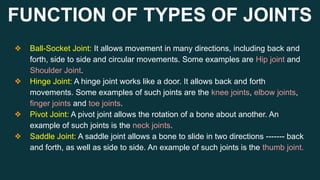Moving and growing (grade 4) ( Science )
- 1. Moving and Growing By: Anushay Abrar
- 2. Bones and the Skeleton ● The hard parts inside your body are called bones. ● There are 206 bones in the body of an human adult. ● The bones form the skeleton of your body. ● Babies are born with about 300 bones. ● Bones are made up of a mineral called Calcium. (e.g Milk) ● Blood is made in the bone marrow which fills some bones.
- 3. Functions of the Human Skeletons ★ The skeleton is like the wooden framework of a house. ★ A skeleton supports the human body and gives it a shape. ★ Without a skeleton for support, we would be as floppy as a jelly fish on land. ★ The human skeleton protects important organs, such as the brain, eyes, heart and lungs. ★ It allows a human being to move.
- 4. Skeletons of other animals Skeleton of a Snake Skeleton of a Fish Skeleton of a Bat Skeleton of Bird
- 5. Skeletons of other animals ➢ Not all animals have skeletons inside their bodies. Some animals have skeletons outside their bodies, while others have no skeletons at all. ➢ The animals that have skeletons are outside their bodies are called Exoskeletons. ➢ Crabs, Lobsters, Beetles and Spiders are some examples of Exoskeletons. ➢ Earthworm, Leech and Slugs are some animals that do not have
- 7. JOINTS What is a Joint? ➔ A joint is where two or more bones meet. ➔ Types of Joints: ➔ Ball-and socket joint -------------- l.e.g Hip joint ➔ Hinge Joint ----------------- Elbow Joint ➔ Pivot Joint ------------------- Neck Joint ➔ Saddle Joint -------------------- Thumb Joint
- 8. FUNCTION OF TYPES OF JOINTS ❖ Ball-Socket Joint: It allows movement in many directions, including back and forth, side to side and circular movements. Some examples are Hip joint and Shoulder Joint. ❖ Hinge Joint: A hinge joint works like a door. It allows back and forth movements. Some examples of such joints are the knee joints, elbow joints, finger joints and toe joints. ❖ Pivot Joint: A pivot joint allows the rotation of a bone about another. An example of such joints is the neck joints. ❖ Saddle Joint: A saddle joint allows a bone to slide in two directions ------- back and forth, as well as side to side. An example of such joints is the thumb joint.
- 9. ● Muscles are made up of tough, elastic fibres that contract (shorten) and relax to enable you to move. ● Muscles enable us to move. ● Without muscles, you will not be able to walk, run, jump or dance and even smile, talk, chew and breathe. ● In fact, you will not be able to live without muscles because your heart is a muscular pump which works non-stop to keep you alive. MUSCLES AND TENDONS
- 10. ● Some muscles in your body, such as your biceps,are attached to bones. ● When these skeletal muscles contract, they pull on the bones and the bones move. ● Skeletal muscles can only pull but they cannot push. ● Thus, they have to work in pairs. ● Not all muscles are attached to bones, your heart muscles and those in the walls of your stomach and intestines are not attached to bones. ● They contract and relax to enable movements that you cannot control. MUSCLES AND TENDONS
- 11. TENDONS ❏ Tendons are strong cords in our body that attach muscles to bones. ❏ When you bend and straighten your arm, the tendon that connects your biceps to your lower arm bone moves. ❏ The strongest and largest tendon is the Achilles tendon that connects the muscles in the lower leg to the heel bone. How did the Achille tendon got its name? ★ The Achilles tendon got its name from a Greek warrior named Achilles.
- 12. 20 The human












